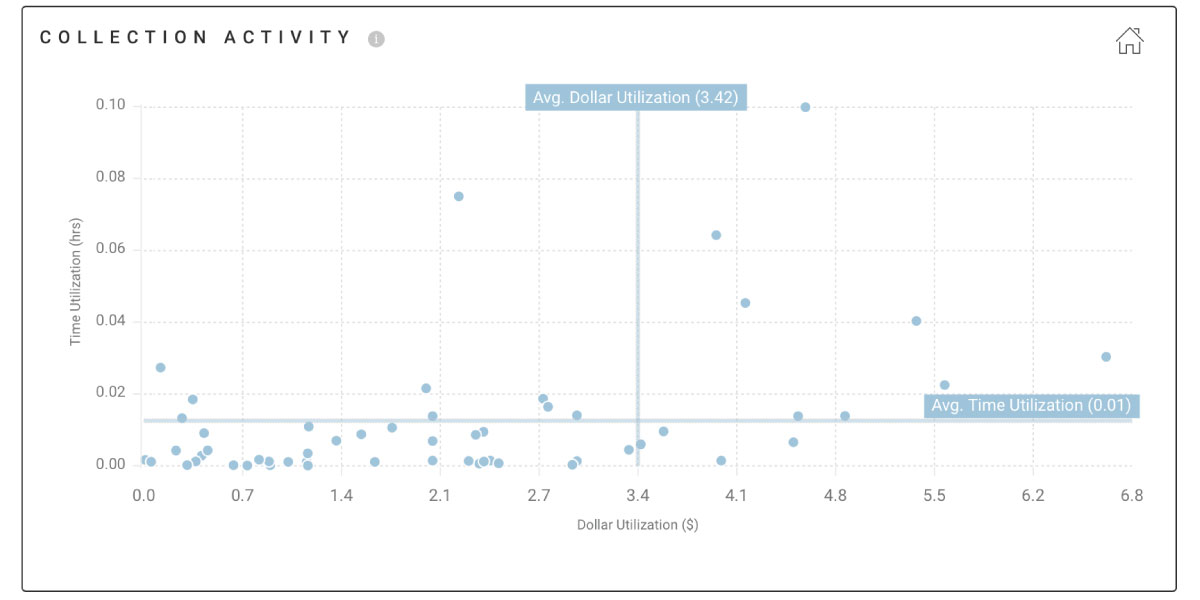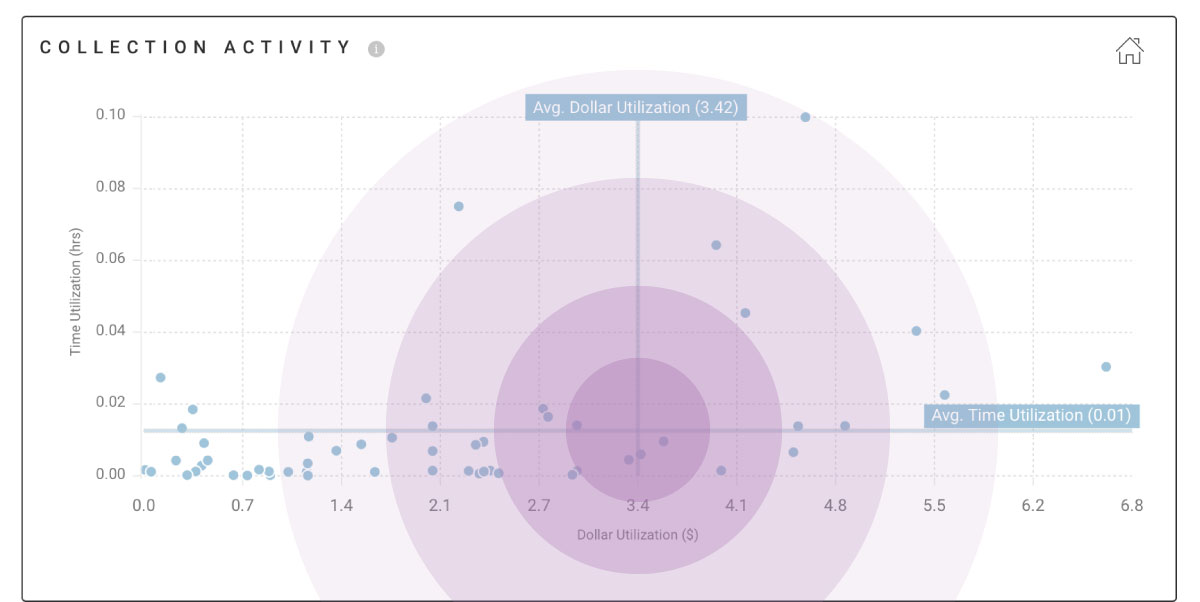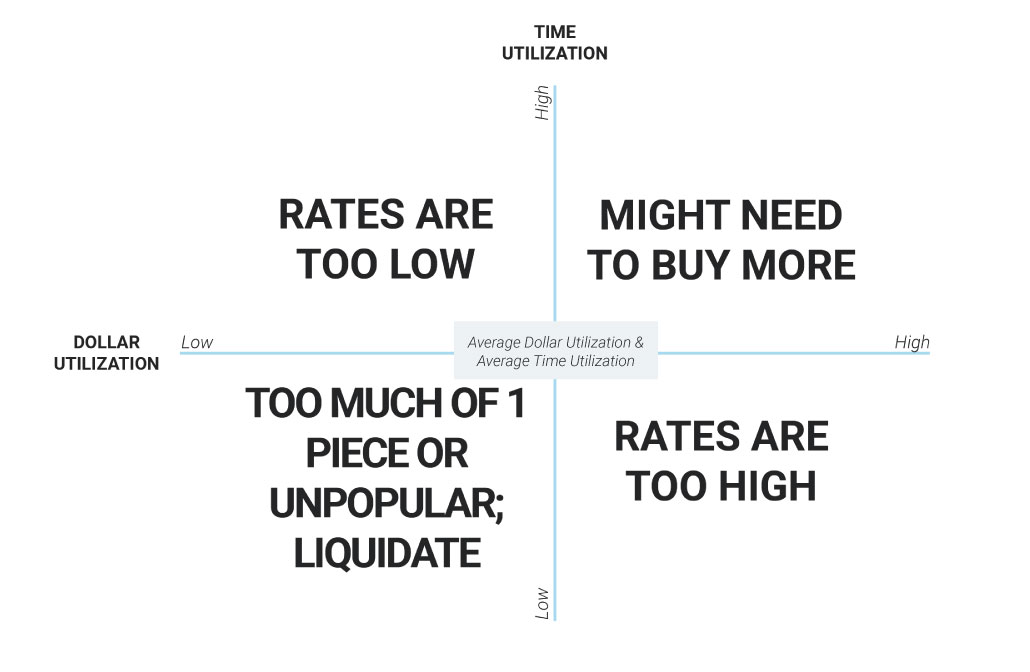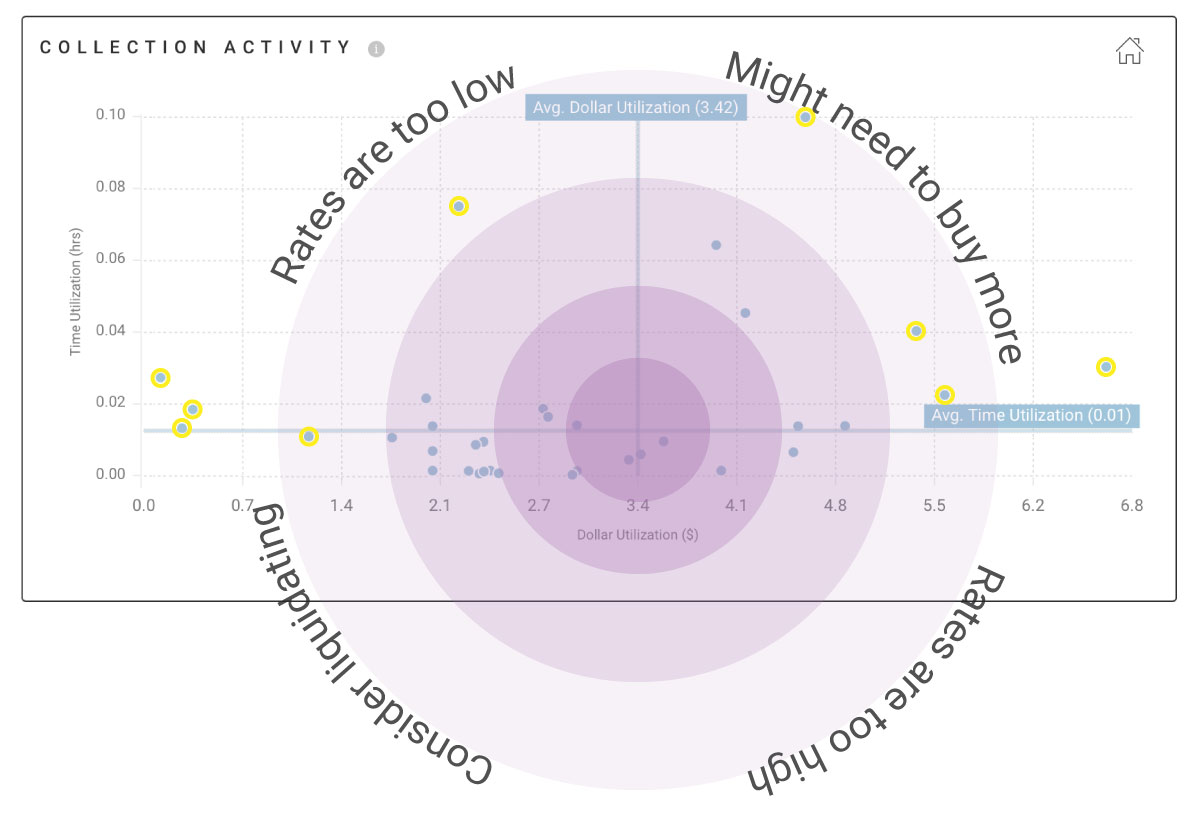Let’s talk about Utilization. Time Utilization and Dollar Utilization are the standardized ways we can think about the performance of your collection in your event rental business.
Time Utilization is the amount of time the item (or the collection as a whole) is out of or your warehouse. It can be measured in weeks, days, hours, or minutes but basically it’s a ratio. Out of 365 days in the year, how many of those days was the Item out of the warehouse? 100 out of 365 equals 0.27.* If it only went out 15 days in the last year, it will have a Time Utilization of 0.04.
Dollar Utilization helps us see how much money an Item has generated in the trailing twelve months compared to the amount that was spent on it originally. If a Farm Table originally cost you $400 in labor and materials to make and has generated $1200 in revenue in the last twelve months, it has a Dollar Utilization of 3. It doesn’t matter if you spent the $400 within the last year or 10 years ago, you always use the original acquisition cost (plus any improvements you’ve made initially or over time like reupholstery or painting, but not cost of repair from damages). You can determine the Dollar Utilization for your collection as a whole or by Category or by Item.
Understanding your Rental Collection’s Utilization is helpful when making decisions about the future of your event rental business. Consider that you should always have two goals in mind. The first is to be ever increasing the average Dollar Utilization of your collection as a whole— the amount of return on investment from your Rental Items.
In this chart, you can see the Collection Activity Metric from within RW Elephant. It shows each Item in a Collection on a chart comparing Time Utilization and Dollar Utilization. The blue axes show the average Dollar Utilization and Time Utilization.

You always want that average (where the blue lines intersect) to be moving to the right over time indicating that, as a whole, your collection is making you more money for every dollar you’ve invested in it.
The second utilization goal is to have as many of your Items as close to your average Dollar Utilization and Time Utilization as possible.
Why care about having most of your pieces be average in this regard? If you’re able to have most pieces in your collection around the same Dollar Utilization and Time Utilization, you’re able to really hone in on profitability. If you’ve got some pieces that are out all the time but not making you a lot of money or pieces that never leave your warehouse, you can’t easily make decisions that impact your collection as a whole. In order to maximize the profitability of your whole collection, you’ll want the performance of most of your pieces to be closely connected.
To say this is a goal is perhaps a misnomer, actually. When most of your Items are close to your average Time Utilization and Dollar Utilization, it is an indication that you’ve hit a sweet spot for price and demand.
In this graphic, you’ll see concentric circles surrounding that average point on the graph.

If you have Items that are far above or below average, they need your attention. The further away a point is from that center average—the more of an outlier it is— the more quickly you’ll need to do something about it.
But how do you know what to do to maximize profitability for a piece? The action you take for an outlier will depend on the quadrant in which it falls.
- Items with high Time Utilization and low Dollar Utilization likely have prices that are too low. You should raise the rates so they will rent less frequently but make you more money overall.
- Items with high Time Utilization and high Dollar Utilization are popular and you need to buy more of that piece or similar pieces to meet that need.
- Items with low Time Utilization and low Dollar Utilization are unpopular or you have too much of a particular piece. You should consider liquidating it or at the very least putting the piece on probation (see Five Ways to Squeeze More Money Out of That Piece.)
- Items with low Time Utilization and high Dollar Utilization likely have rates that are too high. You should lower their prices so they will rent more frequently.

Notice the outlier Items have been highlighted in yellow below. These are the Items that need attention first. Those Items that are farthest from the average require action first.

When you consider all of these factors in concert: strategizing your pricing, liquidating or putting items on probation, and purchasing based on demand, you’ll see that average Dollar Utilization for your entire collection will go up (goal #1) AND more of your Items will be aligned with the averages (goal #2).
In addition to looking at individual Items within your Collection and your collection as a whole, consider comparing Utilization for Categories within your collection. For instance, how does your Flatware’s Dollar Utilization compare to that of your Upholstered Furniture? Are there whole categories in your collection that should be put on probation or liquidated because they just don’t have the Utilization numbers of the other categories? If you sold that category and used the capital to buy more of something else, would that money be producing a higher return-on-investment somewhere else?
And within a category, how does Couch A compare to Couch B? How do they each compare to the average for their category? What can be done to increase the Dollar and Time Utilization of each of them?
Rather than look strictly at the number of times a particular Item has gone out or the amount of money it has brought in (or your gut feeling), look at Dollar Utilization and Time Utilization for your Collection, your Categories, and your Items. These metrics will level the playing field to help you make objective decisions about the investment you’ve made in all of these beautiful rentals.
For more insight about Utilization, have a listen to RW Elephant Co-founder and CEO, Allison Howell, on Annette Stepanian’s Podcast Office Talk.
* Within RW Elephant Time Utilization is measured based on Off-the-Shelf and Restock Times (not Event Start and End Times).
** We’ve created a Utilization & Liquidation Worksheet to help you strategize what to do with underperforming pieces in your rental collection. Download it here.
Also, download a FREE PDF on How to Use RW’s Collection Activity Metric.
